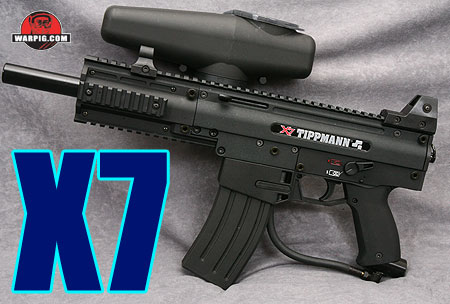
Tippmann X7
by Bill Mills - Photos by Dawn Mills - Nov 2007
Features HowItWorks Disassembly Adjustment Testing Data
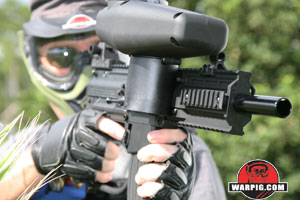 In the 1980s, Dennis Tippmann, Sr. got his first taste of paintball. At the time he was in the business of producing working scale model machine guns (.22 cal scaled down from .50 cal) that were basically high-cost gift/collector items. He recognized that the pump-action pistol style markers of the day placed a serious firepower limitation on players. He developed and marketed the SMG-60 as his answer to that problem, and it was full of innovation. Not only was it the first volume produced marker to cross the boundary from pump or bolt action to semi-auto, but it was even select fire, pulling the trigger all the way to the back let it empty its 15-round magazine of .62 caliber paintballs in full-auto.
In the 1980s, Dennis Tippmann, Sr. got his first taste of paintball. At the time he was in the business of producing working scale model machine guns (.22 cal scaled down from .50 cal) that were basically high-cost gift/collector items. He recognized that the pump-action pistol style markers of the day placed a serious firepower limitation on players. He developed and marketed the SMG-60 as his answer to that problem, and it was full of innovation. Not only was it the first volume produced marker to cross the boundary from pump or bolt action to semi-auto, but it was even select fire, pulling the trigger all the way to the back let it empty its 15-round magazine of .62 caliber paintballs in full-auto.
While that quickly led to a ban on full-auto at most paintball fields and under field insurance policies, it would be more than a decade until being able to select between firing modes was a common feature among other paintguns. The modern ASA connection was another innovation found on the SMG-60. Rather than using hoses and valves with large knobs (also known as “California style” CA,) the SMG-60's CO2 tank screwed into the back of the marker, acting as a stock – something that is the accepted standard today (though, most now screw into the bottom of the grip like Colin Thompson's LAPCO Bottom-Line.)
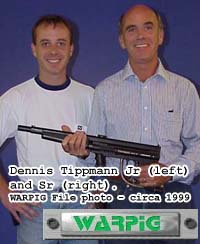 Over the years, Tippmann has come out with new markers, moving first to the industry standard .68 caliber paint, and then to regular hopper feed and semi-automatic operation – with a few side detours into pumps and even a propane powered paintgun. Through that time, the company has maintained a strong reputation for products that are extremely durable, and for outstanding customer service, typically repairing and replacing failed equipment beyond the terms of their warranty agreements.
Over the years, Tippmann has come out with new markers, moving first to the industry standard .68 caliber paint, and then to regular hopper feed and semi-automatic operation – with a few side detours into pumps and even a propane powered paintgun. Through that time, the company has maintained a strong reputation for products that are extremely durable, and for outstanding customer service, typically repairing and replacing failed equipment beyond the terms of their warranty agreements.
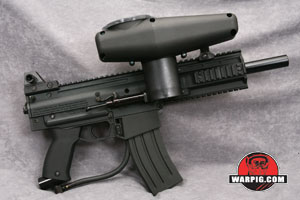 Tippmann's modern marker line began with the Model 98, where a move to a die-cast clamshell body, and new trigger group produced a marker with an entry level price tag, light weight, excellent durability, and a comfortable trigger pull. The Model 98 has been one of paintball's most successful markers, seeing much use both as a beginner's marker and as a field rental. The next step past the 98 line was the A5, a marker working on the same basic operating principles, but restyled a bit more like an H&K MP5. Its military styling was a hit with milsim oriented players, but it also came with a serious performance boost – the cyclone feed system. Based off the concept of a clockwork driven (wind it up every 100 shots) loader system used on the short-lived Tippmann F/A, the Cyclone feed is a force-feed loader that is perfectly indexed to the marker's firing timing, because it is powered by excess blowback gas from the marker's valve. The Cyclone lets a player achieve higher rates of fire without having to invest in a more expensive electronic loader as an upgrade for their marker.
Tippmann's modern marker line began with the Model 98, where a move to a die-cast clamshell body, and new trigger group produced a marker with an entry level price tag, light weight, excellent durability, and a comfortable trigger pull. The Model 98 has been one of paintball's most successful markers, seeing much use both as a beginner's marker and as a field rental. The next step past the 98 line was the A5, a marker working on the same basic operating principles, but restyled a bit more like an H&K MP5. Its military styling was a hit with milsim oriented players, but it also came with a serious performance boost – the cyclone feed system. Based off the concept of a clockwork driven (wind it up every 100 shots) loader system used on the short-lived Tippmann F/A, the Cyclone feed is a force-feed loader that is perfectly indexed to the marker's firing timing, because it is powered by excess blowback gas from the marker's valve. The Cyclone lets a player achieve higher rates of fire without having to invest in a more expensive electronic loader as an upgrade for their marker.
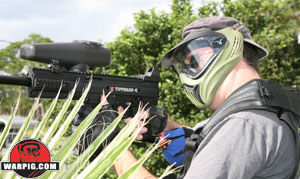 Out west, one company was capitalizing on the success of the A5 and Model 98. Special Ops Paintball positioned themselves as a purveyor of markers and accessories for scenario and milsim oriented players – or as they like to say, woodsball players. They have both distributed and manufactured a wide variety of accessories for Tippmann's markers, all aimed at allowing paintball players to build a milsim marker to their personal taste. Modularity has been a key to many of these components.
Out west, one company was capitalizing on the success of the A5 and Model 98. Special Ops Paintball positioned themselves as a purveyor of markers and accessories for scenario and milsim oriented players – or as they like to say, woodsball players. They have both distributed and manufactured a wide variety of accessories for Tippmann's markers, all aimed at allowing paintball players to build a milsim marker to their personal taste. Modularity has been a key to many of these components.
 Thus it should come as little surprise that a marker born out of a collaboration between Tippmann and Spec Ops would be extremely modular and ready to take a boatload of accessories from the word go. Such is the X7, which was released in late 2006.
Thus it should come as little surprise that a marker born out of a collaboration between Tippmann and Spec Ops would be extremely modular and ready to take a boatload of accessories from the word go. Such is the X7, which was released in late 2006.
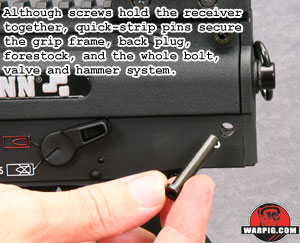 For owners of the Tippmann A5, the X7 will be very familiar. Its receiver is a die-cast magnesium alloy with the same type of valving, loader and quick-strip pin system. The clamshell body (cast in two halves) is held together with hardened steel screws. These screws do not thread into the body halves, but rather into hardened steel nuts that fit into hexagonal recesses in the opposite body half, eliminating the possibility of stripped threads in the softer allow of the body. Its styling however is decidedly more milsim, with more accessory rails, a dummy magazine, thumb lever safety and accessory mounting points.
For owners of the Tippmann A5, the X7 will be very familiar. Its receiver is a die-cast magnesium alloy with the same type of valving, loader and quick-strip pin system. The clamshell body (cast in two halves) is held together with hardened steel screws. These screws do not thread into the body halves, but rather into hardened steel nuts that fit into hexagonal recesses in the opposite body half, eliminating the possibility of stripped threads in the softer allow of the body. Its styling however is decidedly more milsim, with more accessory rails, a dummy magazine, thumb lever safety and accessory mounting points.
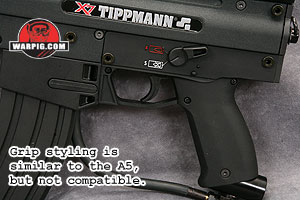 The X7 grip frame is molded polymer with a Eurogrip style enclosed grip (there are no rubber grip panels.) On the left side of the grip is a thumb selector switch, clearly marked for safe and fire positions. The style of this safety mimics those found on H&K assault rifles, and is quite easy to use from a natural grip position, even without looking at the grip frame.
The X7 grip frame is molded polymer with a Eurogrip style enclosed grip (there are no rubber grip panels.) On the left side of the grip is a thumb selector switch, clearly marked for safe and fire positions. The style of this safety mimics those found on H&K assault rifles, and is quite easy to use from a natural grip position, even without looking at the grip frame.

 On Tippmann's optional X7 e-grip, the thumb selector has a third position for an additional electronically selectable mode such as burst or full auto. While most markers can have their electronics “locked” to semi-auto which most fields require, the X7 e-grip's external selector switch is rare among markers in that where full-auto is legal, the rest of the marker's features can be locked, and the player isn't forced to stay in full-auto mode constantly, they can easily switch modes back and forth without breaking a shooting-stance or even needing to look at the marker.
On Tippmann's optional X7 e-grip, the thumb selector has a third position for an additional electronically selectable mode such as burst or full auto. While most markers can have their electronics “locked” to semi-auto which most fields require, the X7 e-grip's external selector switch is rare among markers in that where full-auto is legal, the rest of the marker's features can be locked, and the player isn't forced to stay in full-auto mode constantly, they can easily switch modes back and forth without breaking a shooting-stance or even needing to look at the marker.
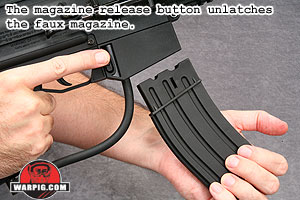 The X7 trigger group will look very familiar to any A-5 owner. The sear, trigger, trigger latch, mounting dowels and springs are all in a self-contained package that can be lifted out of the grip frame as a complete assembly for service. Like the A-5 and M98 series, both the trigger and trigger guard can be removed as separate components, making the change from single finger trigger to two-finger trigger an easy switch of two inexpensive parts, rather than a complete grip frame change.
The X7 trigger group will look very familiar to any A-5 owner. The sear, trigger, trigger latch, mounting dowels and springs are all in a self-contained package that can be lifted out of the grip frame as a complete assembly for service. Like the A-5 and M98 series, both the trigger and trigger guard can be removed as separate components, making the change from single finger trigger to two-finger trigger an easy switch of two inexpensive parts, rather than a complete grip frame change.
Forward of the grip frame, most of Tippmann's more recent markers have had a vertical ASA. The ASA of the A-5 connects into the marker's valve with a rounded slab of metal that has come to be known as the tombstone, due to its shape. The X7 has no ASA, but in its stock configuration, a bottom-line hose runs up to a tombstone connector, hooking into the valve. This is secured in place by the magazine adapter and a quick-strip pin.
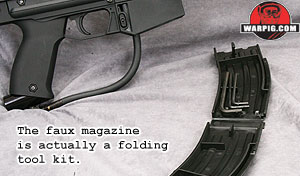 While the X7 feeds its paint from a hopper, its magazine is more than cosmetic. The polymer faux magazine clips into the magazine port much as a real firearm magazine, except that when removed, it opens up to reveal a compact tool kit, with clips for three hex wrenches and an ampule of paintgun oil. While this is convenient for those playing renegade paintball, those players at organized fields should remember that in order to prevent unsafe and unsupervised velocity adjustment cheating, almost all paintball fields and events prohibit players from bringing tools on the field of play.
While the X7 feeds its paint from a hopper, its magazine is more than cosmetic. The polymer faux magazine clips into the magazine port much as a real firearm magazine, except that when removed, it opens up to reveal a compact tool kit, with clips for three hex wrenches and an ampule of paintgun oil. While this is convenient for those playing renegade paintball, those players at organized fields should remember that in order to prevent unsafe and unsupervised velocity adjustment cheating, almost all paintball fields and events prohibit players from bringing tools on the field of play.
Both the faux magazine and its mount may be replaced with alternative styles ranging from a long curved AK-47 look-alike, to a model patterned after a slender, straight 9mm.
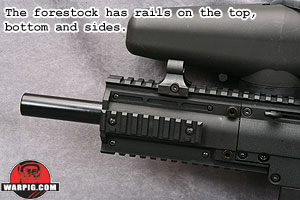 Forward of the magazine lies the marker's forestock or barrel shroud, covering the rear portion of the barrel. Secured by a couple of quick-strip pins, the forestock mimics the marker's overall lines, with a Picatinny style accessory rail on the bottom, one on each side, and one on the top. On either side of the foregrip is an attachment point for a sling. The forestock is another area where the X7 is a quick-change disguise artist.
Forward of the magazine lies the marker's forestock or barrel shroud, covering the rear portion of the barrel. Secured by a couple of quick-strip pins, the forestock mimics the marker's overall lines, with a Picatinny style accessory rail on the bottom, one on each side, and one on the top. On either side of the foregrip is an attachment point for a sling. The forestock is another area where the X7 is a quick-change disguise artist.
A wide variety of alternative forestocks are available with looks that range from an M-16 or AK-47 to one that conceals the curved barrel of a Flatline system for players who want the extended flat trajectory provided by backspin. Unlike many aftermarket accessory forestocks for the A-5, those for the X7 secure directly to the marker's receiver, rather than the barrel. This means they won't unexpectedly twist, unscrewing the barrel.
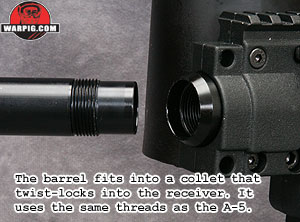 Underneath the forestock is a smoothbore 8-1/2-inch A5 threaded barrel. Midway down the barrel is a ring of 11 ports which vent gas into the foregrip, helping to muffle the marker's sound signature.
Underneath the forestock is a smoothbore 8-1/2-inch A5 threaded barrel. Midway down the barrel is a ring of 11 ports which vent gas into the foregrip, helping to muffle the marker's sound signature.
 On the right hand side of the marker is its Cyclone feed mechanism. Stacked star shaped impellers in the extra wide feedneck rotate 1/5 of a turn each time the marker is fired, driving a new paintball into the breech as soon as it opens. The mechanism is powered by some of the blowback gas that vents out of the rear of the X7 valve. This gas is fed into a pneumatic ram, that has “turbo venting” - rings of ports around the cylinder which allow gas to quickly escape from its forward motion, and expose relief ports when it reaches the end of its stroke, to allow faster cycling than the original Cyclone feed. Tippmann rates the X7's cyclone feed as capable of 20 balls per second.
On the right hand side of the marker is its Cyclone feed mechanism. Stacked star shaped impellers in the extra wide feedneck rotate 1/5 of a turn each time the marker is fired, driving a new paintball into the breech as soon as it opens. The mechanism is powered by some of the blowback gas that vents out of the rear of the X7 valve. This gas is fed into a pneumatic ram, that has “turbo venting” - rings of ports around the cylinder which allow gas to quickly escape from its forward motion, and expose relief ports when it reaches the end of its stroke, to allow faster cycling than the original Cyclone feed. Tippmann rates the X7's cyclone feed as capable of 20 balls per second.
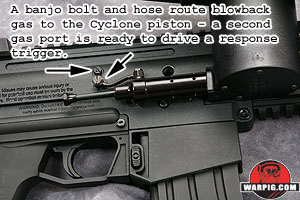 The X7 hopper uses the same wide feedneck as hoppers for the A-5, though its shape is longer and more squat, providing a lower overall profile.
The X7 hopper uses the same wide feedneck as hoppers for the A-5, though its shape is longer and more squat, providing a lower overall profile.
A very retro and less obvious feature is found on the right side of the marker. Along the top of the grip frame and bottom of the receiver, there is a slight outward bulge, like a slender sausage embedded into the design. This expansion provides room for an optional internal gas line.
When Tippmann introduced the back-bottle CO2 arrangement with the SMG-60, other manufacturers soon followed suit. Those that had markers with a hammer behind the valve typically used a series of brass fittings and tubing soldered or threaded into the side of the marker to route the gas.
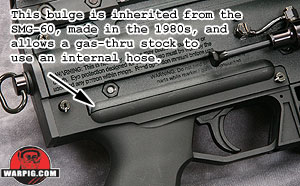 Tippmann went to a flexible hose, but kept it inside the marker, making room for it with a nearly identical bulge to that found on the X7. Now this space is available to hold a gas line not for an out of fashion back bottle, but for a gas-through stock. Among the variety of stocks available for the X7, a number are equipped with quick-disconnect fittings for a remote at their rear, and have a gas line ending with a tombstone fitting in the front. This keeps all the hosing internal to the marker for a clean look that is far more milsim than plumbing supply store.
Tippmann went to a flexible hose, but kept it inside the marker, making room for it with a nearly identical bulge to that found on the X7. Now this space is available to hold a gas line not for an out of fashion back bottle, but for a gas-through stock. Among the variety of stocks available for the X7, a number are equipped with quick-disconnect fittings for a remote at their rear, and have a gas line ending with a tombstone fitting in the front. This keeps all the hosing internal to the marker for a clean look that is far more milsim than plumbing supply store.
The X7's hammer is initially charged by pulling back the cocking handle on the top, left side of the marker. A spring return system mechanically isolates the cocking handle from the hammer, so that it remains in the forward position, rather than sliding back and forth each time the marker fires.
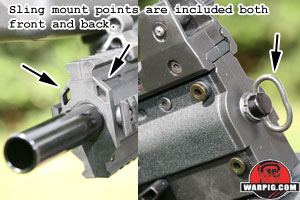 The X7 is bristling with mounting points for sights and accessories. Three and three-quarter inch long Picatinny rails lie on either side of the stock foregrip, appropriate mounting points for laser sights or tactical flashlights. Underneath is a 6-1/4” inch long rail, ready for a bipod, foregrip or other accessory. The top rail 10-7/8ths inches long over the top of the receiver, and matches up to an additional 5 inches of rail on top of the foregrip.
The X7 is bristling with mounting points for sights and accessories. Three and three-quarter inch long Picatinny rails lie on either side of the stock foregrip, appropriate mounting points for laser sights or tactical flashlights. Underneath is a 6-1/4” inch long rail, ready for a bipod, foregrip or other accessory. The top rail 10-7/8ths inches long over the top of the receiver, and matches up to an additional 5 inches of rail on top of the foregrip.
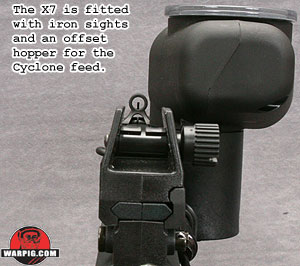 In stock configuration, a hooded post front sight is mounted on the front of the rail, and a knob adjustable open sight is in the rear. The stock iron sight configuration allows for a significant amount of drop between the bore alignment and the sighting point. Gross vertical adjustments can be made by moving the front sight forward or back along the rail, while fine-tuning can be achieved by rotating the knob on the rear sight. Windage (left to right adjustment) is not built in, as the sight rail is aligned parallel to the barrel.
In stock configuration, a hooded post front sight is mounted on the front of the rail, and a knob adjustable open sight is in the rear. The stock iron sight configuration allows for a significant amount of drop between the bore alignment and the sighting point. Gross vertical adjustments can be made by moving the front sight forward or back along the rail, while fine-tuning can be achieved by rotating the knob on the rear sight. Windage (left to right adjustment) is not built in, as the sight rail is aligned parallel to the barrel.
Continue to How It Works .




